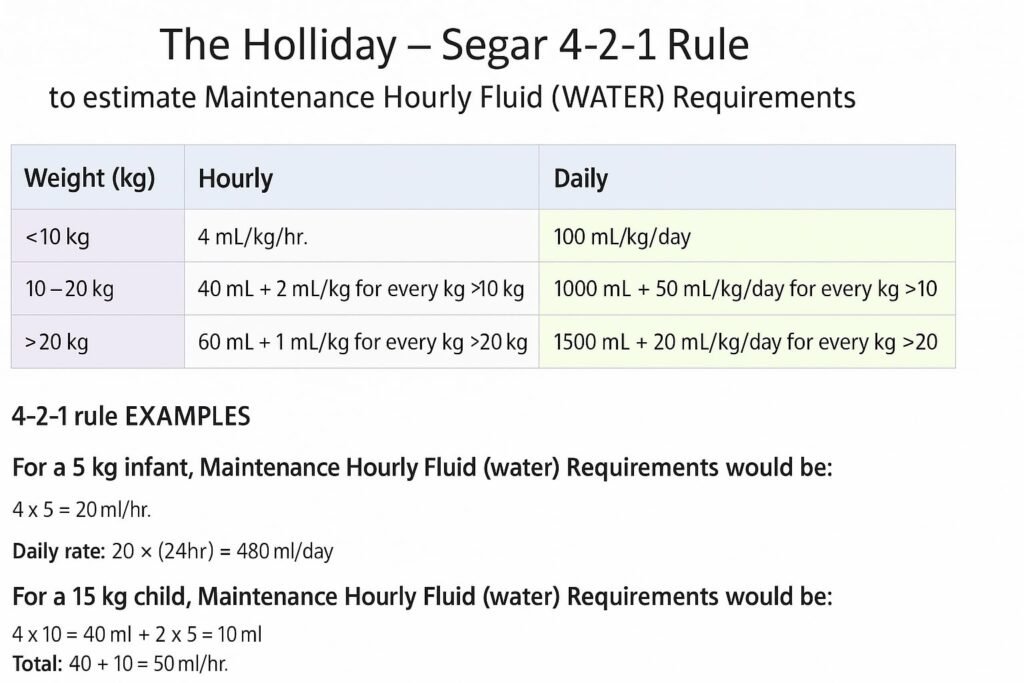Welcome to the Maintenance Fluids Calculator, your go-to tool for instantly determining IV fluid needs using the trusted Holliday–Segar 4/2/1 rule— 4 mL/kg/hr for the first 10 kg, 2 mL/kg/hr for the next 10 kg, and 1 mL/kg/hr thereafter. With a single click you’ll receive:
- Hourly maintenance rate (mL/hr)
- 1.5× adjustment for fever or increased insensible losses
- 20 mL/kg bolus for rapid resuscitation

It handles kg ↔ lbs conversion, supports both pediatric and adult patients, and delivers EMR-ready copy so you can chart confidently and accurately.
Calculates maintenance fluid requirements by weight
Calculate IV maintenance (4/2/1 rule), a 1.5× adjustment for fever/losses, & a 20 mL/kg bolus—instantly.
0 mL/hr
Maintenance0 mL/hr
× 1.5 Adjust0 mL
Bolus (20 mL/kg)🚑 What is the Maintenance Fluids Calculator?
The Maintenance Fluids Calculator is a free online tool designed to help healthcare professionals quickly determine daily fluid requirements for patients, especially children. Based on formulas like the 4-2-1 rule, this calculator ensures accurate IV fluid planning in hospital, clinic, or emergency settings.
Why Use an IV Fluid Maintenance Calculator?
- Minimize dosing errors in high-pressure settings
- Standardize pediatric and adult protocols for hydration therapy
- Account for increased needs (fever, surgical drains, third-spacing)
- Generate EMR-ready copy to paste directly into orders or notes
- Save time versus manual 100/50/20 or 4/2/1 calculations
LSI/NLP keywords: IV drip rate calculator, fluid requirement calculator, pediatric fluid management, adult maintenance fluids, dehydration fluid therapy.
🧠 Supported Fluid Rules
Our calculator supports the following formulas:
| Fluid Rule | Formula | Best For |
|---|---|---|
| 4-2-1 Rule | 4 mL/kg/hr → 2 mL/kg/hr → 1 mL/kg/hr | Pediatric maintenance |
| 100-50-20 Rule | 100 mL/kg → 50 mL/kg → 20 mL/kg | Daily maintenance in children |
| 50-20-10 Rule | 50 mL/kg → 20 mL/kg → 10 mL/kg | Alternate pediatric estimate |
| 20-40-60 Rule | Weight-based volume adjustments | Advanced adult calculations |
How It Works: The Holliday–Segar 4/2/1 Rule
- First 10 kg → 4 mL/kg per hour
- Next 10 kg (11–20 kg) → 2 mL/kg per hour
- Above 20 kg → 1 mL/kg per hour
Total maintenance rate (mL/hr) =
(4 × min(weight, 10)) + (2 × min(max(weight–10, 0), 10)) + (1 × max(weight–20, 0))
- Adjustment (× 1.5): For fever (+12.5% per °C) or high insensible losses
- Bolus (20 mL/kg): Rapid expansion in shock/dehydration
Step-by-Step Usage
- Enter weight (kg or lbs)
- Select unit
- Compute → View three cards: Maintenance, Maintenance ×1.5, Bolus
- Copy Results → Paste into EMR, charting, or hand-off notes
Benefits & Clinical Pearls
- Pediatric NPO runs: Automate hourly IV drip rates
- Adult dehydration: Balance fluid overload risk in heart-failure patients
- Burns & fever: Quickly adjust for increased insensible losses
- ICU & wards: Standardize orders across teams
- Teaching tool: Illustrate the 4/2/1 rule in med-ed settings
Examples
- 15 kg child
- Maintenance: (10×4)+(5×2) = 50 mL/hr
- Adjusted: 50×1.5 = 75 mL/hr
- Bolus: 15×20 = 300 mL
- 70 kg adult
- Maintenance: (10×4)+(10×2)+(50×1) = 110 mL/hr
- Adjusted: 110×1.5 = 165 mL/hr
- Bolus: 70×20 = 1 400 mL
❓ FAQs – Maintenance Fluid Rules
1️⃣ What is the 4 2 1 rule for maintenance fluids?
The 4-2-1 rule estimates hourly fluid needs: 4 mL/kg/hr for the first 10 kg, 2 mL/kg/hr for the next 10 kg, and 1 mL/kg/hr for every kg over 20.
It’s a simplified hourly version of the Holliday–Segar method used in clinical settings.
2️⃣ How to calculate maintenance fluids?
Use the Holliday–Segar method: 100 mL/kg for the first 10 kg, 50 mL/kg for the next 10 kg, 20 mL/kg for each kg above 20.
Divide the total by 24 for hourly rate, or use the 4/2/1 mL/kg/hr shortcut.
3️⃣ What is the 100 50 20 rule for maintenance fluids?
It’s a daily fluid requirement formula: 100 mL/kg/day for the first 10 kg, 50 mL/kg/day for the next 10 kg, and 20 mL/kg/day for weight over 20 kg.
Commonly used to calculate total daily maintenance fluids in pediatrics.
4️⃣ What is the 50 20 10 rule for fluids?
An alternative maintenance fluid guide: 50 mL/kg/day for the first 10 kg, 20 mL/kg/day for the next 10 kg, and 10 mL/kg/day above 20 kg.
Often applied in specific clinical scenarios like older children or calorie restriction.
5️⃣ What is the 20 40 60 rule for fluids?
Used in neonates: give 20 mL/kg/day on day 1, 40 mL/kg/day on day 2, and 60 mL/kg/day on day 3.
The volume gradually increases as kidney function and feeding tolerance improve.
6️⃣ What is the 1% rule for maintenance?
For every 1% loss in body weight due to dehydration, about 10 mL/kg of fluid needs to be replaced.
This rule helps estimate fluid deficit correction over 24 hours.
Source: https://www.mdcalc.com/calc/72/maintenance-fluids-calculations





